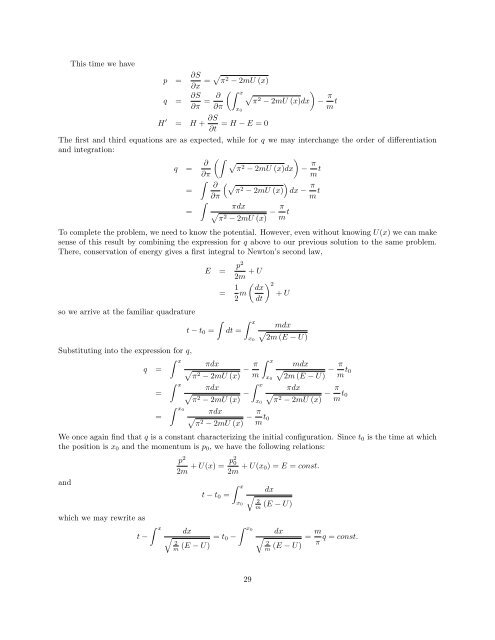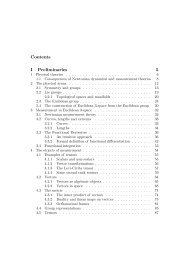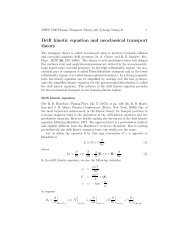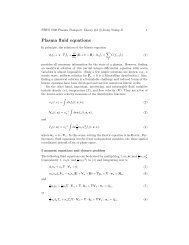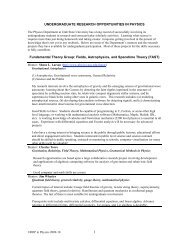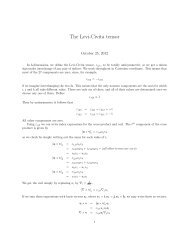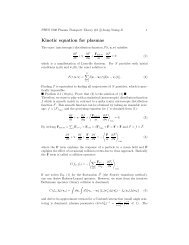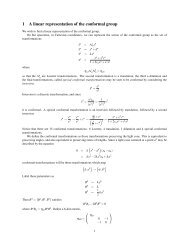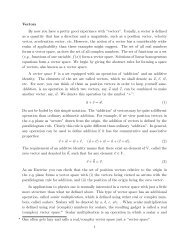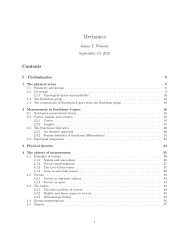Hamiltonian Mechanics
Hamiltonian Mechanics
Hamiltonian Mechanics
Create successful ePaper yourself
Turn your PDF publications into a flip-book with our unique Google optimized e-Paper software.
This time we have<br />
p = ∂S<br />
∂x = √ π 2 − 2mU (x)<br />
q = ∂S<br />
∂π = ∂ (ˆ x<br />
)<br />
√<br />
π2 − 2mU (x)dx − π ∂π x 0<br />
m t<br />
H ′ = H + ∂S<br />
∂t = H − E = 0<br />
The first and third equations are as expected, while for q we may interchange the order of differentiation<br />
and integration:<br />
q = ∂ (ˆ √π2<br />
− 2mU (x)dx)<br />
− π m t<br />
=<br />
=<br />
∂π<br />
ˆ<br />
ˆ<br />
∂<br />
∂π<br />
(√<br />
π2 − 2mU (x))<br />
dx − π m t<br />
πdx<br />
√<br />
π2 − 2mU (x) − π m t<br />
To complete the problem, we need to know the potential. However, even without knowing U(x) we can make<br />
sense of this result by combining the expression for q above to our previous solution to the same problem.<br />
There, conservation of energy gives a first integral to Newton’s second law,<br />
E = p2<br />
2m + U<br />
= 1 2 m ( dx<br />
dt<br />
so we arrive at the familiar quadrature<br />
ˆ<br />
t − t 0 = dt =<br />
Substituting into the expression for q,<br />
q =<br />
=<br />
=<br />
ˆ x<br />
ˆ x<br />
ˆ x0<br />
ˆ x<br />
x 0<br />
πdx<br />
√<br />
π2 − 2mU (x) − π m<br />
) 2<br />
+ U<br />
mdx<br />
√<br />
2m (E − U)<br />
ˆ x<br />
x 0<br />
mdx<br />
√<br />
2m (E − U)<br />
− π m t 0<br />
ˆ<br />
πdx<br />
x<br />
√<br />
π2 − 2mU (x) − πdx<br />
√<br />
π2 − 2mU (x) − π m t 0<br />
x 0<br />
πdx<br />
√<br />
π2 − 2mU (x) − π m t 0<br />
We once again find that q is a constant characterizing the initial configuration. Since t 0 is the time at which<br />
the position is x 0 and the momentum is p 0 , we have the following relations:<br />
and<br />
which we may rewrite as<br />
t −<br />
ˆ x<br />
p 2<br />
2m + U(x) = p2 0<br />
2m + U(x 0) = E = const.<br />
t − t 0 =<br />
ˆ x<br />
dx<br />
√<br />
= t 0 −<br />
2<br />
m (E − U)<br />
x 0<br />
√<br />
ˆ x0<br />
2<br />
m<br />
dx<br />
(E − U)<br />
dx<br />
√<br />
= m<br />
2<br />
m (E − U) π q = const.<br />
29


